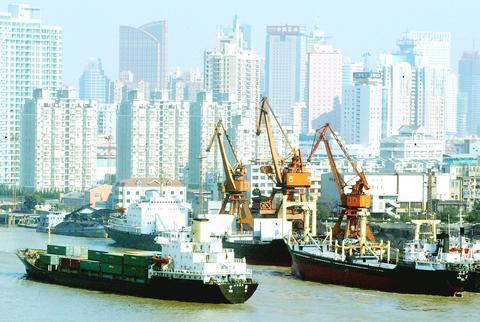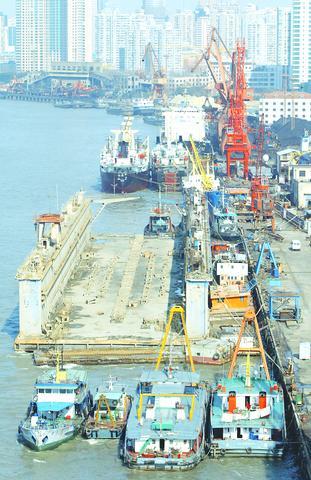Few people recall Shanghai's roaring heyday of the 1920s, when the thriving city on China's eastern seaboard housed a warren of brothels, opium dens, underground casinos and lorded over Asian trade.
Hong Kong was then a sleepy backwater.
How things change. Today China's biggest city finds itself in the reverse position, with the former British colony the undisputed heavyweight of trade and commerce in Asia.

PHOTO: REUTERS
But China's rising star in the 21st century could turn the tables once again. And that's what a Shanghai government obsessed with reclaiming its shipping crown is counting on.
At stake are annual trade flows worth more than US$850 billion between the world's sixth-largest economy and the rest of the planet -- a torrent of goods choking ports as far afield as Australia, Brazil and West Africa.
"Shanghai was already a shipping hub in the 1930s. Hong Kong was nothing," said Jiaotong University professor Xin Yuanou.

"The city just needs five to 10 years before it can once again become a port to rival Hong Kong or Singapore."
But industry experts say Shanghai, the most populous city in the world's fastest-growing country, is missing one key element: a deep water port to rival Hong Kong's.
So the city will create one. The Yangshan Islands port -- a US$12 billion undertaking -- will transform a fishing village into a world-class harbor spanning 18km2 and shipping 20 million twenty-foot equivalent units (TEUs) a year by 2020.

The project would displace more than 1,400 families and reclaim 20 million cubic meters of land -- enough to fill a hole 2km, 100m wide and another 100m long.
They plan to succeed where the British failed.
"Shanghai has a rich history as an international port. Did you know the English tried to build a port at Yangshan in the 19th century?" asked Zhang Huimin, a deputy secretary-general of the city's government.
Since then, China has become the world's factory and Shanghai has enticed billions of dollars in foreign investment, much of it from Hong Kong shipping firms.
New capacity has become a matter of the utmost urgency: industry insiders say ships must wait a month to berth at Shanghai's Beilun port, a major iron ore import terminal.
The city's resolve to change that is plain to see.
At Yangshan island some 30km from Shanghai's southernmost district, hundreds of grimy workers in yellow hard hats swarm over mountains of rubble piled several storeys high, dodging swinging cranes and rumbling dump-trucks.
"We need to build a deep-water port so the city will become an international economic, financial, trade and shipping center," said Zhang, echoing the line fed to the city's 20 million people by state-run press.
Officials concede there's a way to go, even with Shanghai surpassing Busan in South Korea to become the world's third-busiest container port in 2003, handling 11.3 million TEUs.
Hong Kong's grid-like rows of towering cranes shift containers in clockwork fashion in the world's busiest port, still the preferred window into China.
And it's not standing still. The territory is building berths to ramp throughput from about 20 million TEUs now to 25 million TEUs by 2005. Singapore moved 18.4 million TEUs in 2003.
To succeed, Shanghai will need foreign help -- and cash.
China Ocean Shipping (Group) Co, parent of COSCO Pacific Ltd, plans to take a 20 percent stake in Yangshan's first phase -- a 14-billion yuan (US$1.7 billion) investment.
Ports giants Hutchison Whampoa Ltd, Wharf Holdings and Singapore's PSA Corp Ltd are also jockeying for a piece of the action.
"In the past few years, development of Shanghai and Shenzhen ports has been very brisk. They will be a threat to Hong Kong in future because of their lower costs," said Wen Bin, an analyst at Merchants Securities in Shenzhen.
At least part of the city's ambition is driven by nostalgia for the past. Residents look back upon the 1920s and early 1930s as Shanghai's "shining era," never equaled since.
Shipping was the era's celebrated industry, and Shanghai was an artery for the silk and tea that flowed between the Orient and the West on full-masted junks and swollen clippers.
Now it wants to do the same, eventually, for everything from microchips to cars.
"There was so much happening back then with Americans and Europeans doing business here. We exported garments to places like Japan," Xin said, reminiscing. "That was a glorious era."

In the March 9 edition of the Taipei Times a piece by Ninon Godefroy ran with the headine “The quiet, gentle rhythm of Taiwan.” It started with the line “Taiwan is a small, humble place. There is no Eiffel Tower, no pyramids — no singular attraction that draws the world’s attention.” I laughed out loud at that. This was out of no disrespect for the author or the piece, which made some interesting analogies and good points about how both Din Tai Fung’s and Taiwan Semiconductor Manufacturing Co’s (TSMC, 台積電) meticulous attention to detail and quality are not quite up to

Chinese Nationalist Party (KMT) Chairman Eric Chu (朱立倫) hatched a bold plan to charge forward and seize the initiative when he held a protest in front of the Taipei City Prosecutors’ Office. Though risky, because illegal, its success would help tackle at least six problems facing both himself and the KMT. What he did not see coming was Taipei Mayor Chiang Wan-an (將萬安) tripping him up out of the gate. In spite of Chu being the most consequential and successful KMT chairman since the early 2010s — arguably saving the party from financial ruin and restoring its electoral viability —

It is one of the more remarkable facts of Taiwan history that it was never occupied or claimed by any of the numerous kingdoms of southern China — Han or otherwise — that lay just across the water from it. None of their brilliant ministers ever discovered that Taiwan was a “core interest” of the state whose annexation was “inevitable.” As Paul Kua notes in an excellent monograph laying out how the Portuguese gave Taiwan the name “Formosa,” the first Europeans to express an interest in occupying Taiwan were the Spanish. Tonio Andrade in his seminal work, How Taiwan Became Chinese,

Toward the outside edge of Taichung City, in Wufeng District (霧峰去), sits a sprawling collection of single-story buildings with tiled roofs belonging to the Wufeng Lin (霧峰林家) family, who rose to prominence through success in military, commercial, and artistic endeavors in the 19th century. Most of these buildings have brick walls and tiled roofs in the traditional reddish-brown color, but in the middle is one incongruous property with bright white walls and a black tiled roof: Yipu Garden (頤圃). Purists may scoff at the Japanese-style exterior and its radical departure from the Fujianese architectural style of the surrounding buildings. However, the property